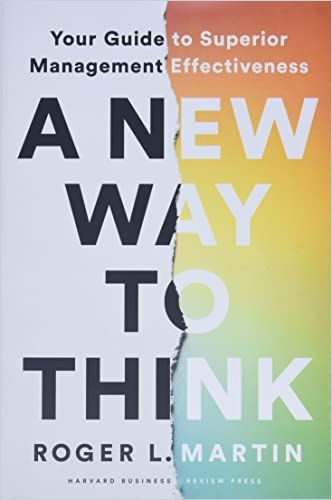Leading strategy adviser Roger L. Martin offers alternatives to outdated business models, advising bold adaptation and experimentation.

Stop Making the Same Mistakes
One of the world’s top business thinkers, Roger L. Martin, compiles some of his best contributions to the Harvard Business Review from the past 12 years, which he’s updated to address current concerns. In this ultimate guide to strategy, mission, culture, and more, Martin describes conventional management models – so-called best practices and familiar frameworks – and explains why they so often fail to deliver.
Drawing on decades of experience advising CEOs in many of the world’s most successful organizations, he proposes desperately needed business model alternatives. Martin’s collection was named among the “10 must-read career and leadership books for 2022” by Forbes. Indeed, his insights offer indispensable management and strategy advice.
If It’s Broke, Fix It
Martin urges business leaders to take a fresh look at entrenched business models and practices. When an approach fails, leaders tend to push harder on it; Martin recommends they instead change or abandon the approach. He believes leaders should stop blaming themselves or their teams for failed initiatives and instead revise their models.
Existing models are extraordinarily persistent in the face of ineffectiveness.Roger Martin
Martin’s “new way to think” means instead of clinging to rigid, often outdated and erroneous models, practices and frameworks, leaders should question them and seek new ones. They should think as a scientist would, forming hypotheses and then trying to disprove them. As the world and business environments change, he opines, no rigidly held framework or model can remain effective.
Integrate Strategy with Execution
In developing strategy, Martin observes, CEOs typically focus on data about the market, customers, products, and so forth, and then make decisions within the frame of the existing landscape. But this approach fails to challenge the status quo. Instead, Martin suggests leaders think in terms of strategic possibilities and identify what would have to change to make those possibilities viable. Martin also warns against confusing planning with strategy. Detailed five-year plans supported by mountains of data and nice spreadsheets might make people feel comfortable, but strategy, in contrast, focuses on key decisions and recognizes risk.
Martin offers a seven-step process for developing strategy. It requires strategists to explore several directions and then scrutinize them against what would have to be true for each to work – the “conditions for success.” Next, strategists should rigorously test the options and make the best choice accordingly. Martin believes in the value of data for validating or invalidating a strategic direction, but he sees imagination as more important. In Martin’s view, imagination helps leaders break away from conventional thinking. Data explains the now, but only imagination can create something new.
One should always use the best model available, but watch closely to see whether it produces the outcomes that it promised.Roger Martin
The notion that execution matters more than strategy has gained currency in recent years, but this idea seldom benefits organizations other than consulting firms, Martin believes. He advises leaders to view strategy and execution as identical and to allow strategy and execution to happen seamlessly at every level of the organization. Employees should help determine strategy and should have wide latitude to decide how to implement it.
Enable Frontline Workers to Serve Customers
Martin reminds readers that customers – through their purchase decisions – determine which products succeed. In most organizations, however, leaders take it upon themselves to understand the market, make product decisions and then issue orders for the rest of the company to follow. Yet senior executives don’t often interact with customers; frontline workers do. Martin reasons that because competition occurs at the level of the product purchase, leaders and managers should organize to support and serve the people below them: They should see their role as enabling frontline workers to understand and serve customers. This role reversal should ensue at every level of the organization, he argues. In Martin’s view, each level should consider the level below as its customer and should strive to provide more value to its “customers” than the costs it imposes.
Put Customers Before Shareholders
Since the 1970s, CEOs and boards have mainly focused on generating shareholder returns. But Martin warns that an obsession with profits practically guarantees an organization won’t achieve them. And actions CEOs take to drive up share prices usually prove to have temporary effects. Martin points out that many CEOs play the game of pursuing short-term gains that pump up the stock briefly but harm the firm in the long run, aiming to get out with a windfall before the stock crashes. Instead, he believes, leaders should put customer satisfaction first, laying the foundations for long-term success and, ultimately, solid increases in shareholder value.
Change Culture from the Bottom Up
Unconventional approaches to strategy, competition and mission make up the bulk of Martin’s book, but he also offers fresh perspectives on the structure of work and key activities, including insights for approaching cultural change, defining jobs, considering acquisitions and valuing investments. With regard to cultural change, Martin cautions against attempting it deliberately or directly. Instead, leaders should push cultural change from the bottom up by organizing work to encourage desired interactions and behavior. Employees should take part in defining the new culture and the behavior that will build it, he advises.
It’s often said that insanity is doing the same thing over and over again but expecting different results.Roger Martin
Martin recommends a project-centric rather than job-centric approach to defining people’s work, taking the model of professional services firms. For every function in the organization, leaders should insist on a documented strategy to align the function with and support overall corporate objectives.
Martin advises decision-makers to base acquisition decisions on the benefits that the acquired organization would gain from the move – this will ensure the target increases in competitiveness and in turn creates value for the buyer. Finally, Martin asks leaders to get real about the value of investments. Rather than assessing them on their cost, Martin suggests valuing them according to their market value.
Experiment and Track Results
Martin doesn’t claim his insights will produce results in every company and under every circumstance, but he asks leaders to consider his suggestions and to think unconventionally about the models and practices they employ. He urges leaders to discover what works by experimenting and tracking the results, whether they stick to established models or try new ones.
Martin’s insights don’t necessarily count as brand new – he’s been publishing the work that appears in this book since 2010 in the Harvard Business Review. But many organizations continue to cling to conventional practices that aren’t serving them and would do well to consider the alternatives Martin outlines – and their presentation here in one volume amplifies their effect.





